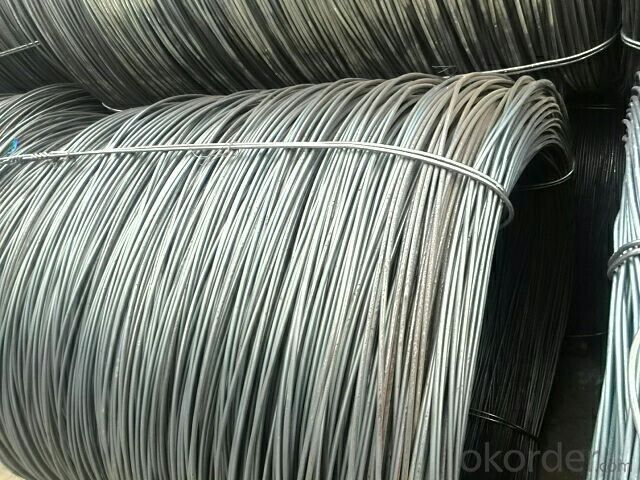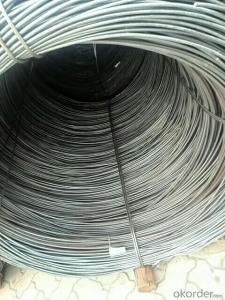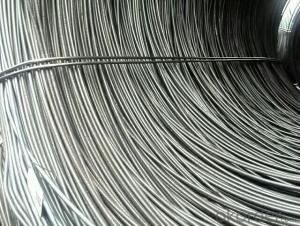Sae1008B AND Sae1006B High quality Wire Rod
- Loading Port:
- Tianjin
- Payment Terms:
- TT OR LC
- Min Order Qty:
- 100 m.t
- Supply Capability:
- 20000 m.t/month
OKorder Service Pledge
OKorder Financial Service
You Might Also Like
Product Description:
OKorder is offering Sae1008B AND Sae1006B High quality Wire Rod at great prices with worldwide shipping. Our supplier is a world-class manufacturer of steel, with our products utilized the world over. OKorder annually supplies products to European, North American and Asian markets. We provide quotations within 24 hours of receiving an inquiry and guarantee competitive prices.
Product Applications:
Sae1006B AND Sae1008B High quality Wire Rod are ideal for structural applications and are widely used in the construction of buildings and bridges, and the manufacturing, petrochemical, and transportation industries.
Product Advantages:
OKorder's Sae1008B AND Sae1006B High quality Wire Rodare durable, strong, and resist corrosion.
Main Product Features:
· Premium quality
· Prompt delivery & seaworthy packing (30 days after receiving deposit)
· Corrosion resistance
· Can be recycled and reused
· Mill test certification
· Professional Service
· Competitive pricing
Product Description:
Specifications of Sae1006B AND Sae1008B High quality Wire Rod :
Steel Grade: sae1006+sae1008B , Standard: GB Diameter: 5.5mm, 6.5mm, 7mm,8mm,9mm,10mm,12mm,14mm
Diameter Tolerance:±0.3mm 6.5mm can be drawing into 2mm/8.0mm can be drawing into 3mm
Brand Name: N-RIVER Place of Origin: Hebei, China Mainland Application: construction, building etc
Chemical Composition:
Please kindly find our chemistry of our material based on Q235 as below for your information
Trademark | Rank | Chemical composition (quality score) % | ||||||
C | Si | Mn | S | P | ||||
| ≤ |
| ≤ | ≤ | ||||
Q235 | A | 0.14-0.22 | 0.30 | 0.30-0.65 | 0.050 | 0.045 | ||
Q235 | B | 0.12-0.20 | 0.30 | 0.30-0.70 | 0.045 | 0.045 | ||
Trademark | Rank | Pulling Test | ||||||
Bend PointΔs/Mpa | Tensile Strength | Elongation Ratioδ5% | ||||||
Thickness (Diameter) /MM | Thickness (Diameter) /MM | |||||||
≤16 | 16-40 | ≤16 | 16-40 | |||||
≥ | ≥ | |||||||
Q235 | A | 235 | 225 | 375-500 | 26 | 25 | ||
Q235 | B | 235 | 225 | 375-500 | 26 | 25 | ||
Usage and Applications of Sae1008B AND Sae1006B High quality Wire Rod :
After hot-rolled the products shaped into coil and delivery as finished product, including round, square, rectangular, hexagonal and so on. Since most of the products are round, it is generally called wire rod. Carbon steel wire rod is widely used in construction and manufacturing. Carbon steel wire rod is mainly used for reinforcement of reinforced concrete and welded structure or reprocessed (roberts , nail, etc.) materials, especially used to produce wire drawing, welding electrode, nails, spring, electronic, precise machinery parts and so on.
Packaging & Delivery of Wire Rod Sae1006B AND Sae1008B :
Packaging Detail: products are packed in coil and then shipped by container or bulk vessel
Each coil weight: 2-3MT
Delivery Detail: within 45 days after received deposit or LC.
Label: to be specified by customer, generally, each bundle has 1-2 labels
Trade terms: FOB, CFR, CIF
FAQ:
Q1: Why buy Materials & Equipment from OKorder.com?
A1: All products offered byOKorder.com are carefully selected from China's most reliable manufacturing enterprises. Through its ISO certifications, OKorder.com adheres to the highest standards and a commitment to supply chain safety and customer satisfaction.
Q2: Can stainless steel rust?
A2: Stainless does not "rust" as you think of regular steel rusting with a red oxide on the surface that flakes off. If you see red rust it is probably due to some iron particles that have contaminated the surface of the stainless steel and it is these iron particles that are rusting. Look at the source of the rusting and see if you can remove it from the surface.
Q3: What is the normal tolerance of Hot Rolled Mild Steel Angle Beams for Structures and for Buildings?
A3: Normally 3%-5%, but we can also produce the goods according to the customers' requests.
Images:


- Q:What are the safety considerations when handling steel wire rods?
- When handling steel wire rods, there are several important safety considerations to keep in mind. 1. Personal Protective Equipment (PPE): It is essential to wear the appropriate PPE to protect yourself from any potential hazards. This may include safety glasses, gloves, and steel-toed boots to prevent injuries from falling rods or accidental contact. 2. Proper Lifting Techniques: Steel wire rods can be heavy and awkward to handle. It is crucial to use proper lifting techniques, such as bending your knees and lifting with your legs, to prevent strains or back injuries. 3. Storage and Handling: Steel wire rods should be stored in a designated area that is well-organized and secure. They should be stacked in a stable manner to prevent them from falling over and causing injuries. Additionally, it is important to ensure that the rods are not exposed to moisture or extreme temperatures, as this can affect their integrity. 4. Sharp Edges and Points: Steel wire rods often have sharp edges and points, which can cause cuts or puncture wounds. It is important to handle them with care and use appropriate tools, such as wire cutters or pliers, to avoid direct contact with the sharp areas. 5. Transport and Loading: When transporting or loading steel wire rods, it is essential to secure them properly to prevent them from shifting or falling during transit. This may involve using appropriate tie-downs, straps, or other restraints to keep the rods in place. 6. Training and Awareness: All individuals handling steel wire rods should receive proper training on safe handling procedures and be aware of potential hazards. Regular safety meetings and reminders can help reinforce the importance of following safety protocols. By considering these safety measures, you can help mitigate the risks associated with handling steel wire rods and ensure a safe working environment for all involved.
- Q:What are the different types of steel wire rod rolling processes?
- There are several different types of steel wire rod rolling processes, including hot rolling, cold rolling, and warm rolling. Each process has its own advantages and is used for specific applications. Hot rolling involves heating the steel rod and then passing it through a series of rollers to reduce its diameter and increase its length. Cold rolling, on the other hand, is performed at room temperature and results in a smoother finish and increased strength. Warm rolling is a combination of hot and cold rolling, where the steel rod is heated to a lower temperature than in hot rolling but higher than in cold rolling. This process offers a balance between strength and surface quality.
- Q:How is steel wire rod used in the production of wire mesh for industrial sieving?
- Wire mesh for industrial sieving relies heavily on steel wire rod, which plays a vital role in its production. This mesh finds widespread application in industries like mining, construction, and agriculture, where it is used to separate and classify materials based on their size and shape. To create wire mesh, the steel wire rod undergoes a series of manufacturing steps, transforming it into a suitable form. The rod is typically subjected to wire drawing, a process that involves passing it through a series of dies to reduce its diameter and increase its length. As a result, the wire becomes thin and elongated. Once the wire rod has been drawn, it is either woven or welded together to form the wire mesh. Weaving involves interlacing the wires in a crisscross pattern, creating a strong and durable structure. Conversely, welding involves fusing the wires at their intersections using heat or pressure, resulting in a solid and stable mesh. The choice between weaving and welding depends on specific requirements. Weaving is ideal for producing wire mesh with smaller openings and finer mesh sizes, while welding is preferable for larger openings and heavier wire diameters. The steel wire rod used in wire mesh production offers various advantages for industrial sieving. Firstly, steel is a highly durable and robust material, capable of withstanding harsh environments and heavy loads. This ensures that the wire mesh remains structurally intact even when subjected to constant material impact during the sieving process. Additionally, steel wire rod provides excellent tensile strength, enabling the wire mesh to maintain its shape and resist deformation under tension. This is particularly important for high-pressure sieving applications or situations where the mesh needs to be tightly stretched over a frame. Furthermore, steel wire rod can be coated or treated to enhance its resistance to corrosion, abrasion, and other forms of wear and tear. This prolongs the lifespan of the wire mesh, making it suitable for long-term industrial use. In conclusion, steel wire rod is a crucial component in the production of wire mesh used for industrial sieving. Its versatility, durability, and strength make it an ideal raw material for creating wire mesh capable of withstanding rigorous sieving applications in various industries.
- Q:How are steel wire rods used in the manufacturing of mesh screens?
- Mesh screens rely heavily on steel wire rods as a fundamental ingredient in their production. These rods are typically crafted from top-notch steel, known for its robustness, longevity, and resistance to corrosion. The initial step involves selecting the appropriate grade of steel wire rod, based on the desired specifications for the mesh screen. The steel wire rods undergo a series of processes to prepare them for use. These processes include cleaning, straightening, and cutting, ensuring that the rods are devoid of impurities and possess the correct dimensions. Once the wire rods are prepared, they are fed into a mesh weaving machine. This machine is equipped with multiple weaving heads, which intertwine the wire rods both horizontally and vertically, creating a grid-like structure. The interlacing process can be performed in various patterns, such as plain weave, twill weave, or Dutch weave, depending on the intended application of the mesh screen. Throughout the weaving process, the steel wire rods are tightly woven together, resulting in a mesh that is both sturdy and flexible. This mesh structure offers numerous advantages, including heightened strength, resilience, and resistance to deformation. Following the weaving process, the mesh screens may undergo additional treatments to further enhance their properties. These treatments may involve heat treatment or surface coating, aiming to augment the mesh's resistance to rust, abrasion, or chemical corrosion, depending on the specific requirements of its application. In summary, steel wire rods play a pivotal role in the production of mesh screens by providing the essential material for weaving the mesh structure. The resulting mesh screens find application in diverse industries, such as construction, mining, agriculture, filtration, and security, among others. Their versatility, strength, and durability make them an ideal choice for a wide range of applications.
- Q:Can steel wire rod be recycled?
- Yes, steel wire rod can be recycled. Steel is a highly recyclable material that can be melted down and reused to create new products. Recycling steel wire rods helps conserve natural resources and reduce waste.
- Q:What are the main factors influencing the choice of steel wire rod payment terms?
- There are several main factors that can influence the choice of payment terms for steel wire rod. One of the primary factors is the financial stability and creditworthiness of the buyer. If the buyer has a strong financial position, the seller may be more willing to offer favorable payment terms, such as longer payment periods or installment payments. On the other hand, if the buyer has a poor credit history or financial instability, the seller may require stricter payment terms, such as upfront payment or shorter payment periods. The market conditions and competition can also impact the choice of payment terms. In a highly competitive market with multiple suppliers, the seller may need to offer more flexible payment terms to attract buyers. This could include options like deferred payment or payment upon delivery. Conversely, in a market with limited suppliers or high demand, the seller may have more leverage and can dictate stricter payment terms. The nature of the business relationship between the buyer and seller is another crucial factor. If the buyer and seller have a long-standing relationship with a history of successful transactions, the seller may be more willing to offer favorable payment terms as a gesture of trust and loyalty. Additionally, the volume and frequency of purchases can also influence the payment terms. Buyers who consistently purchase large quantities of steel wire rod may have more negotiating power and be able to secure more favorable payment terms. Lastly, external factors such as economic conditions, currency fluctuations, and government regulations can also impact the choice of payment terms. In times of economic uncertainty or currency volatility, sellers may be more cautious and require stricter payment terms to mitigate their risk. Similarly, government regulations related to international trade or finance can also affect the choice of payment terms. Overall, the main factors influencing the choice of payment terms for steel wire rod include the financial stability of the buyer, market conditions, the nature of the business relationship, and external factors such as economic conditions and government regulations.
- Q:How are steel wire rods used in the production of wire coat hangers for hanging clothes?
- Steel wire rods are essential in the production of wire coat hangers for hanging clothes due to their durability and strength. These rods serve as the main material used to create the frame and shape of the coat hangers. Firstly, the steel wire rods are cut into the desired length for the coat hangers. This ensures that each hanger is of the appropriate size for hanging clothes. The rods are then bent and shaped using specialized machinery to form the classic triangular shape that we commonly associate with coat hangers. Next, the ends of the wire rods are smoothed and rounded off to prevent any sharp edges that could potentially damage the clothing. This step is crucial to ensure that the hangers are safe to use and won't cause any harm to the clothes being hung. Once the wire rods have been shaped and smoothed, they are coated with a protective layer, usually made of plastic or rubber. This coating serves multiple purposes. Firstly, it prevents the steel rods from rusting or corroding over time, ensuring the longevity of the coat hangers. Additionally, the coating provides a non-slip surface that helps prevent clothes from sliding off the hanger. Finally, the coated wire rods are attached to a hook at the top, which allows the hangers to be hung on a closet rod or any other suitable hanging mechanism. This hook is usually made of a separate material, such as plastic or metal, and is securely attached to the wire rod to ensure the stability and functionality of the coat hanger. Overall, steel wire rods play a vital role in the production of wire coat hangers by providing the strength, durability, and shape necessary for hanging clothes. Their versatility and ability to be shaped and coated make them an ideal material for creating reliable and long-lasting coat hangers.
- Q:What are the main factors influencing steel wire rod pricing?
- The main factors influencing steel wire rod pricing include the cost of raw materials such as iron ore and scrap metal, energy prices, production costs, market demand and supply dynamics, global economic conditions, and government policies and regulations. Additionally, factors like transportation costs, currency exchange rates, and the competitive landscape can also impact steel wire rod pricing.
- Q:What are the common production processes for cobalt-coated steel wire rod?
- The common production processes for cobalt-coated steel wire rod typically include wire drawing, cleaning, coating, and heat treatment.
- Q:How is a steel wire rod manufactured?
- A steel wire rod is manufactured through a process called hot rolling. It begins with heating a large steel billet in a furnace until it reaches a malleable temperature. The billet is then passed through a series of rolling mills, which gradually reduce its diameter and increase its length. This process is repeated multiple times to achieve the desired size and shape. Once the rod reaches its final dimensions, it is cooled, coiled, and then ready for further processing or usage in various industries.
1. Manufacturer Overview |
|
|---|---|
| Location | |
| Year Established | |
| Annual Output Value | |
| Main Markets | |
| Company Certifications | |
2. Manufacturer Certificates |
|
|---|---|
| a) Certification Name | |
| Range | |
| Reference | |
| Validity Period | |
3. Manufacturer Capability |
|
|---|---|
| a)Trade Capacity | |
| Nearest Port | |
| Export Percentage | |
| No.of Employees in Trade Department | |
| Language Spoken: | |
| b)Factory Information | |
| Factory Size: | |
| No. of Production Lines | |
| Contract Manufacturing | |
| Product Price Range | |
Send your message to us
Sae1008B AND Sae1006B High quality Wire Rod
- Loading Port:
- Tianjin
- Payment Terms:
- TT OR LC
- Min Order Qty:
- 100 m.t
- Supply Capability:
- 20000 m.t/month
OKorder Service Pledge
OKorder Financial Service
Similar products
New products
Hot products
Related keywords




























